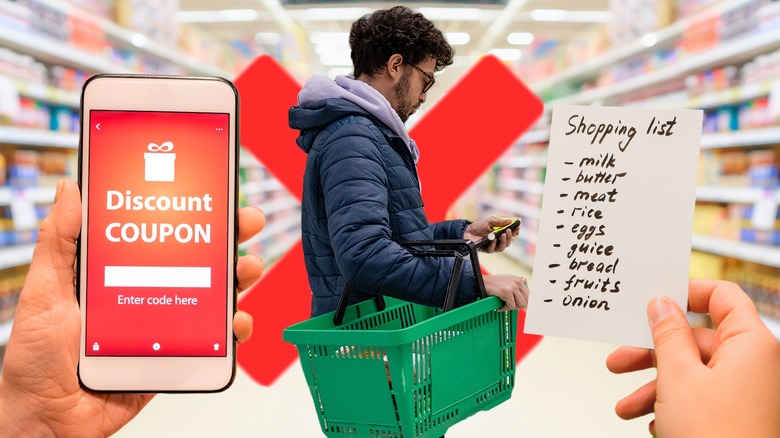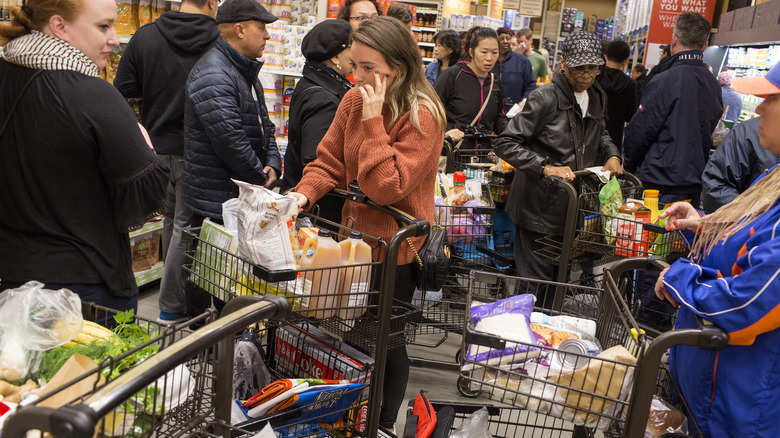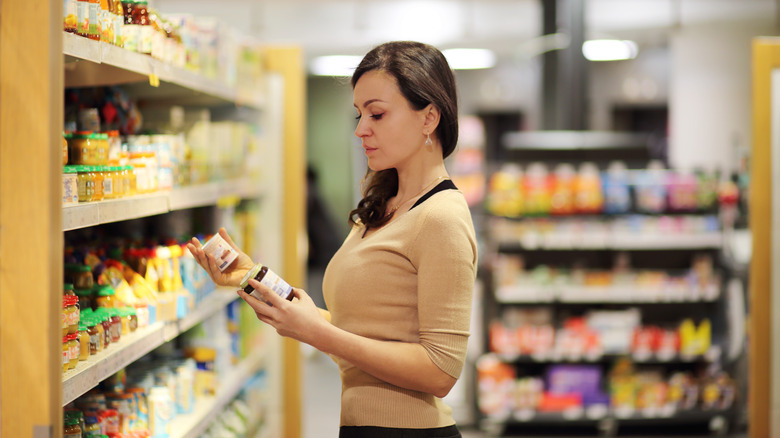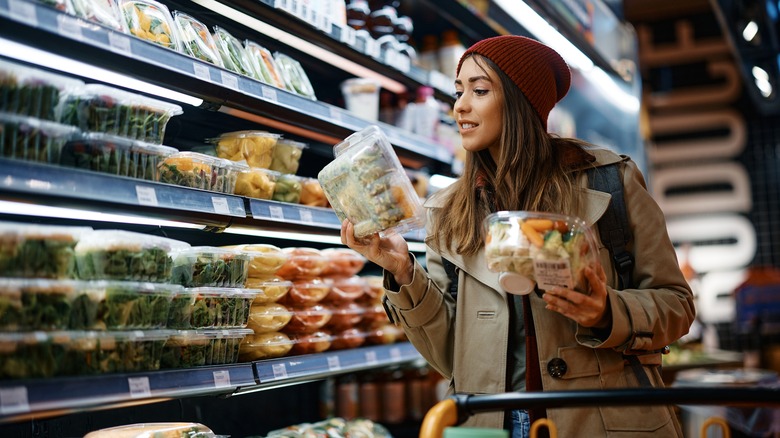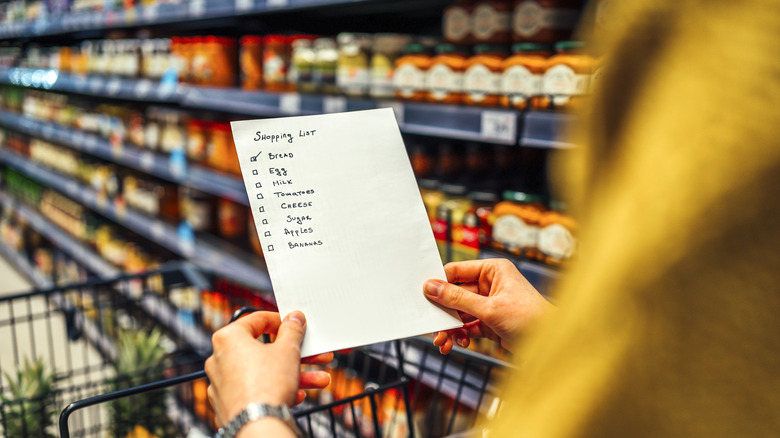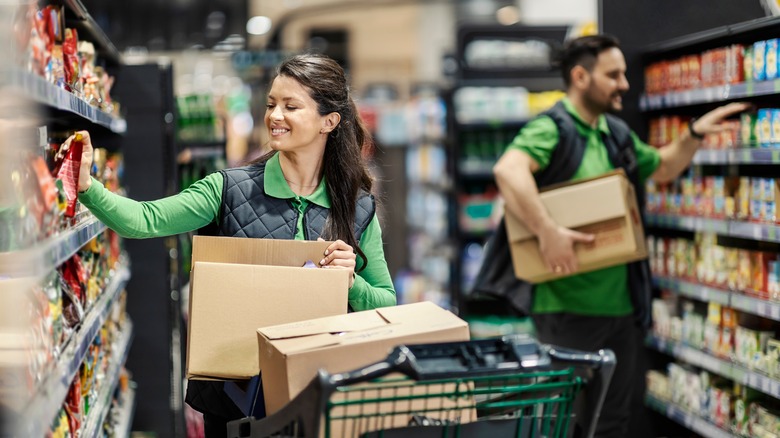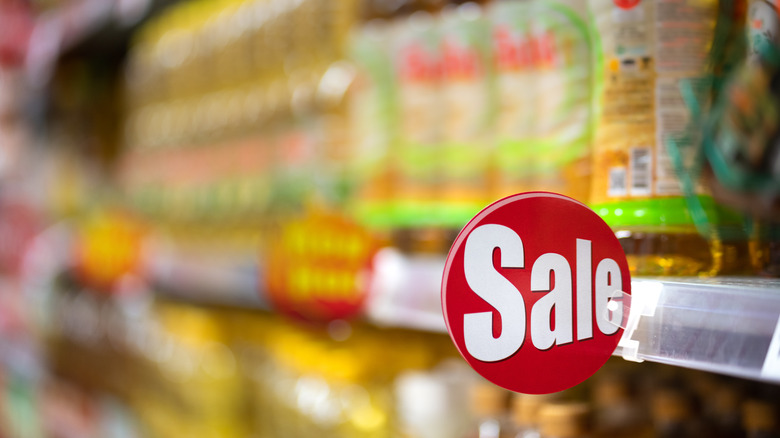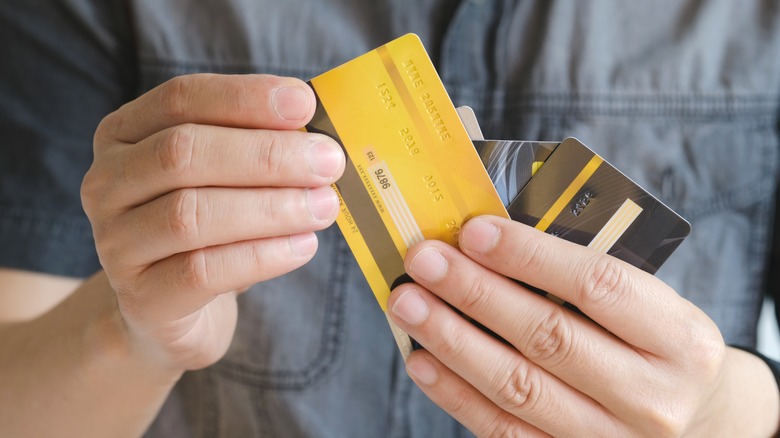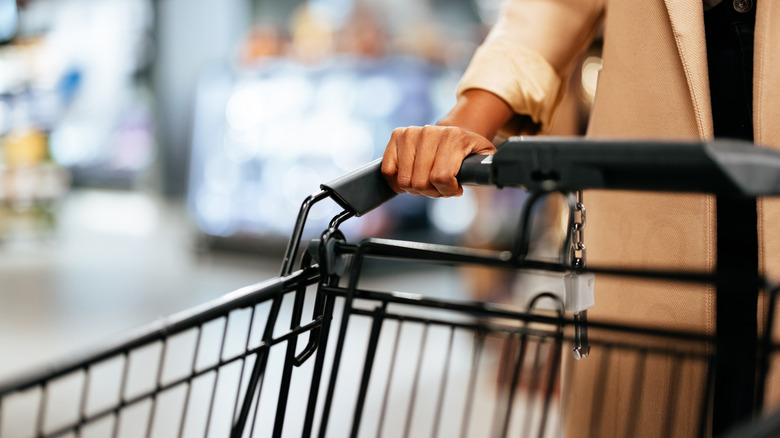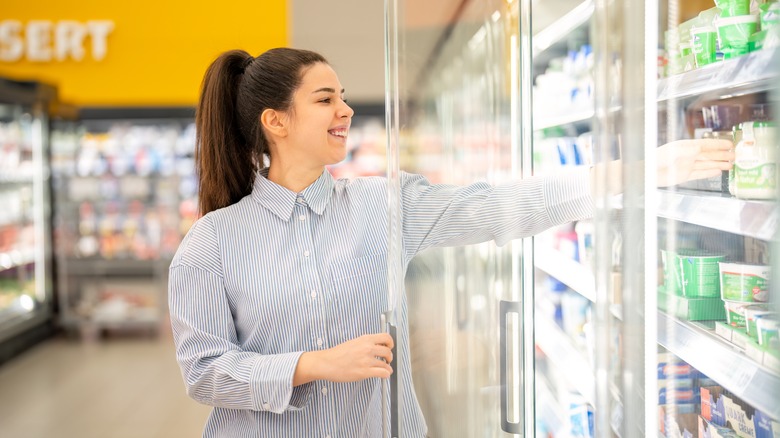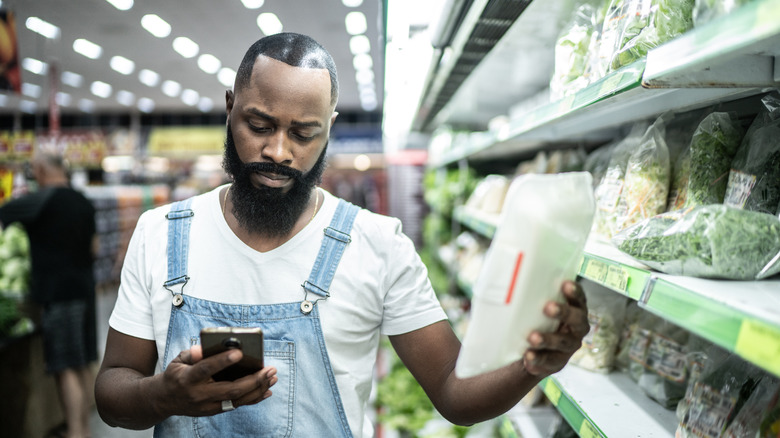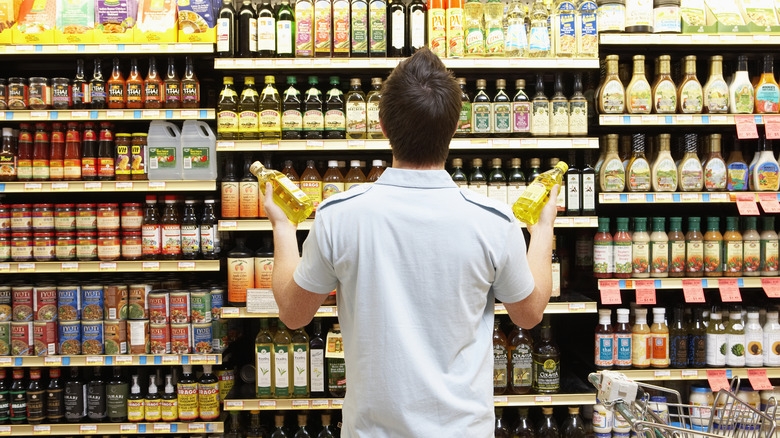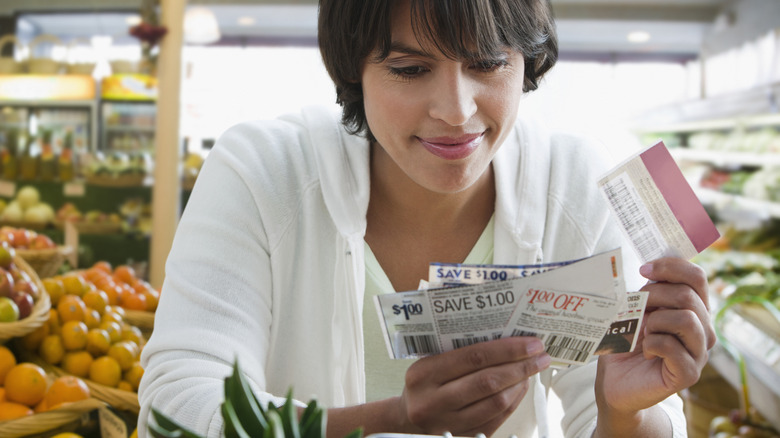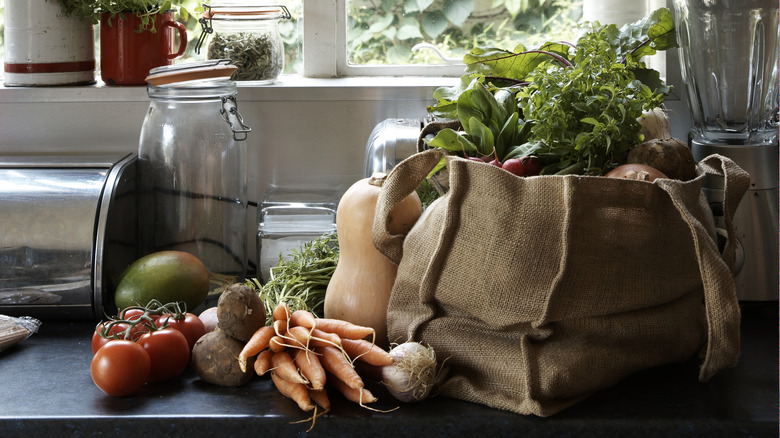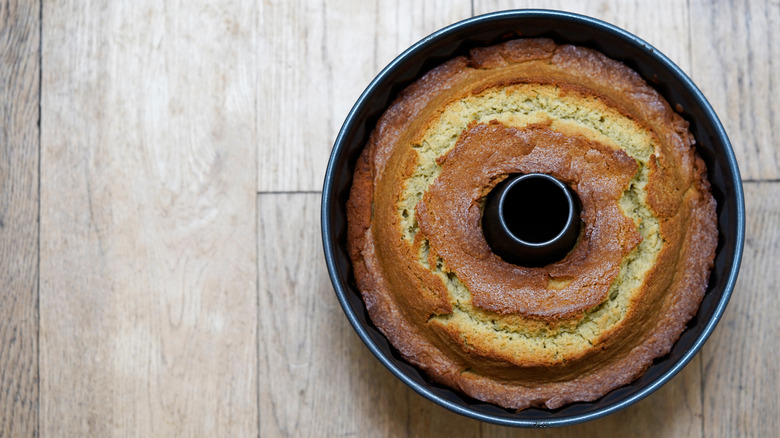16 Grocery Shopping Mistakes To Be Mindful Of
Maximizing efficiency and savings during a shopping trip is paramount to our mental and financial health. Navigating the labyrinth of a large supermarket, even a familiar one, can be a feat akin to heading into battle, one that should never be undertaken without preparation and helpful advice. But the good news is that we have all the tips and tricks you need to succeed during your next grocery trip without losing your mind or declaring bankruptcy.
It all comes down to a few simple steps. First of all, you have to go in with a plan. A shopping list may seem like something for amateurs, not veterans who have been braving the supermarket trenches for years. But as you will see, planning is essential to any shopper, no matter how seasoned.
Likewise, you can't just go to the store whenever you please. An off-peak visit is very different from rush-hour shopping, and choosing the wrong time of day can lead to all sorts of scourges, like being forced to buy sub-par produce because all the good stuff has already been taken. So, let's take a look at strategies to improve your next grocery shopping trip by avoiding the following mistakes.
Arriving late in the day
Even with the best of intentions, we all end up putting off our grocery shopping trips. Perhaps we meant to wake up early and get it done in the morning, or tried to finish a work project in a hurry so we could fit a supermarket trip into our lunch break. But in the end, we find that the only time we can get it done is after work, at the exact same time as everyone else.
As human as this mistake may be, it could end up costing more than you bargained for. Not only will your sanity be affected by the massive crowds that start swarming the aisles starting at around 4:30 p.m., but access to your favorite ingredients will be limited by the simple fact that someone has gotten there before you.
So, next time you have to go shopping, try to make the Herculean effort to do it in the morning, right as the store opens. That also happens to be when shelves are freshly restocked, making it the best time to go to the grocery store for the highest-quality goods, giving you the pick of the litter in terms of ingredients. This also means you can skip the evening rush and instead grab that drink with friends.
Going grocery shopping with friends
Shopping for clothes with friends can be a fun activity. Not only do you get to spend time together chatting and relaxing, but you can also ask your pals for their opinions on the various outfits you try on. The same is not true for food shopping. That's because our culture reserves clothing shopping for the realm of entertainment, in most cases, while food shopping is a necessity.
For this reason, it's important to remain focused and engaged, and bringing along friends is just going to distract you. They might point out an exciting new ice cream flavor they just discovered, luring you away from your quest for frozen spinach, a key ingredient for your family's soup recipe. Or they might convince you to splurge on a fancy chocolate treat you were determined to avoid, causing you to go over your food budget for the week. You could still encounter such temptations when shopping solo, but the practical reason to shop at the grocery store alone is that you are less likely to make impulse buys when concentrating on the task at hand.
Making the trip on Sunday
No one likes a Sunday driver, especially while attempting to get shopping done in a reasonable amount of time. Indeed, the best way to avoid slow, aisle-clogging shoppers (not to mention actual Sunday drivers in the parking lot) is to stay home on Sundays altogether. This anti-Sunday grocery shopping tip is best executed by saving your store run for a Thursday morning, which is widely considered to be the best time for supermarket visits — most stores are likely to be freshly restocked then to get ready for the weekend.
Sunday may be the one day of the week when you don't have other commitments, but the same is true for everyone else, which is why the whole world seems to converge on supermarkets on this day. So, if you don't mind crowds, mayhem, and a lack of choice ingredients, sure, go on a Sunday. Otherwise, you're best off waiting it out.
Not preparing a shopping list
Even if your mind is a steel trap, and you remember every thought that has ever taken up residence between your ears, there is something organized and soothing about having a nice grocery list that you can hold in your hand and visualize. Not only that, but it's likely that you noticed a lack of toilet paper and milk at different times of the week, and these two items live at different ends of the supermarket.
Plan your grocery list to make your shopping trip more efficient by writing it in the order in which items appear in the grocery store aisles, saving you the trouble of running back and forth. For instance, if the produce section is what you see when you first walk through the door, put your apples and cucumbers on the list first, working your way down to the frozen section, which is typically at the back of the store before you reach the cash registers. Not only will this trick save you time, but it will also help you stick to your budget, as you are less likely to be tempted to grab unplanned items off the shelves.
Creating only one shopping list
Not only is it important to have a shopping list ready before a supermarket trip, but one list might not be enough in all cases. To be safe, it pays to have two grocery shopping lists — one for staples like bread, milk, or salt, while the other consists of more specific items, like ingredients you need to follow a particular recipe or to host a Sunday gathering.
If you think about it, it makes sense that eggs would not be on the same list as balloons. How often do you need balloons compared to eggs? When it comes to household use, they're not even in the same league. Maintaining two separate lists is therefore a helpful way to label each category of items you may need, thereby ensuring that your pantry stays stocked even as the party rages on. You're going to need those eggs the next morning.
Taking the first item displayed on the shelf
There is a not-so-secret strategy that grocery stores use to get their customers to purchase expiring items instead of fresher ones. Nothing is inherently wrong with this, and it's probably a practice that you employ in your own home. But there is also nothing wrong with wanting the freshest possible ingredients that a store has to offer, and for this, you'll need to be in the know.
Avoid the first product on the grocery store shelf, because items that are closer to their expiration dates are stocked in the most convenient spot at the edge directly in front of shoppers, while the fresher products are hiding in the rows behind them. This method is called FIFO (first in, first out), and it does help in the fight against food waste — if more people buy items that are closer to the expiration date, fewer items left on the shelves will have to be thrown out after that date passes. But when buying something that you won't open for weeks, you may want to check the back of the shelf instead of grabbing the first item that you see in the front.
Falling for deceptive sale labels
We all love a good bargain, especially given the spiraling cost of food we've had to endure lately. But desperate times can also lead to devious schemes, and no place is spared, not even the grocery store. In particular, we urge you to be mindful of deceptive sale labels that advertise the offer to purchase five items for $5, or a two-for-the-price-of-one deal. The very reasonable concept presented is that if you buy more of an item, you should get a discount, just like when buying in bulk.
And if it just so happens that you need five containers of strawberries, then all the better for you. But if you're not throwing a chocolate-covered strawberry party anytime soon, you could end up with a lot of rotting strawberries if you fall for this scheme. The thing is, you don't actually have to buy all five of those containers in order to get the deal. In most cases, you can buy just one item and still get the same discounted price for it.
Exceeding your shopping budget
It is ever so easy to exceed our shopping budgets, especially with the levels of inflation that have been plaguing many households since the pandemic. Luckily, we can offer you a few ways to help save money at the grocery store.
For one, don't forget to check specific sections for marked-down items. These might be displayed on the usual shelf, or they could be hiding on a rack tucked behind a refrigerated section somewhere. They typically include foods that are approaching their expiration dates, but that doesn't make them bad or unsafe to eat.
Another strategy is to buy certain items in bulk, which typically comes with a built-in discount and means you won't have to buy those things on another shopping trip at full price. Lastly, be sure to focus on local and seasonal produce. Not only are these items fresher and tastier, but since they travel shorter distances and require less gas to reach you, they also tend to be cheaper.
Not using a shopping cart
Not grabbing a shopping cart is bad grocery store etiquette, even if you're just popping in for a few last-minute items. Let's be honest — how many times have you gone into the supermarket thinking you were just getting milk and eggs, only to end up with ingredients for a feast? This is one reason why it's always a good idea to get that shopping cart. You never know what the future may hold, and a shopping cart can hold a lot more groceries than your arms.
But there are other benefits to using a cart. For one, even if you really are just grabbing eggs and milk, placing these in the cart means you'll be less likely to drop them and make a mess. Second, the cart can help you stay appropriately spaced from other shoppers, which is especially important to many people in this post-pandemic era.
Grabbing cold items first
Grocery shopping in colder climates can be beneficial. In particular, if you grab some ice cream during your store run, you don't have to worry about it melting as you place the container in your car and drive it home. But it's a different story during the summer. In the hotter months, you may have to get strategic about when you take items out of the fridge or freezer section and place them into your cart.
Indeed, we recommend waiting to select the cold items on your list as the last groceries you should grab on every trip. While a large turkey isn't going to defrost between the store and your home freezer, all that time away from refrigeration may affect its freshness. Also, your ice cream really might melt into a puddle if it's hot enough outside. Grabbing these items last, after you've already made your full rounds of the aisles, will help them stay as cold as possible while you transport them home.
Shopping by item price instead of unit price
The large block numbers that appear under each item on the grocery store shelves are intended to inform you about the price of that item. But that's all those numbers are there for. If you want to be savvy about your spending, you may have to break out some math skills. That's because the item price won't tell you much about a product's real worth. That's where the unit price comes in, which tells you how much you'll be spending on something per pound or per ounce.
For instance, you might see a large pack of ramen that sells for a higher price than another, smaller pack of ramen. Don't be fooled by the numbers here. Consider that if you're someone who eats a lot of ramen, you're just going to be back at the store buying another pack in two days, so you may as well splurge on the bigger, more expensive packaging now. In the end, this is no splurge at all — if you look at that unit price, you'll likely see that per pound of ramen, you'll end up spending less on the more expensive larger pack than on the cheaper smaller one.
Forgetting to check the top and bottom shelves
Grocery store stockers are like magicians — they have a whole slew of tricks up their sleeves that few people will notice unless they're trained at looking out for the sleight of hand. They place items with the lowest profit margins on the top and bottom shelves to save room on the eye-level shelves for the more expensive brands and impulse-buy items, strategically placed to best capture our attention.
Ignore these and stay the course by remembering to check the top and bottom shelves first. These will contain the ingredients you actually came shopping for or the brands that you can more easily afford. There is nothing wrong with grabbing whatever you can see right in front of you, especially if you're in a hurry — but if your goal is to be efficient and save money, knowing this tip can be a huge help.
Ignoring coupons
Grocery stores may use a lot of stratagems to get you to spend more, but they also offer ways to save money, including in the form of coupons. These may be presented in several forms, most commonly in a weekly circular you find at the store itself or in publications available at your local newsstand. And of course, these days there are plenty of apps and social media pages that can help you find coupons and other deals.
Do take advantage of these. While on some level these coupons are trying to get you to buy more — and you should indeed be careful against buying things you don't need just because they're cheap — they can also save you a lot of money when deployed strategically. For example, if you go through maple syrup like it's nobody's business, be on the lookout for maple syrup coupons. But if you don't expect to ever need Velveeta, even in a post-apocalyptic scenario, then feel free to skip clipping out that coupon.
Neglecting to bring your own bags
There was a time when people were expected to use disposable grocery store bags when they got through the checkout aisle. Those ubiquitous brown paper bags and plastic sacks ended up filling an entire kitchen cabinet, yet few people thought twice about this situation.
Nowadays, bringing your own bags to the supermarket has become a necessity, depending on where you live. Certain areas have banned single-use plastic bags altogether, so you might not even find a sack to take your food home from the store. In other cases, you may have to buy a new single-use bag every time you go to the supermarket. Skirt this inconvenience by always keeping some reusable shopping bags in your car for impromptu grocery store trips. Not only will this save you money, but you will also contribute to alleviating the planet of extra baggage, literally and figuratively. Depending on the store, you may even get a small discount for bringing your own bag.
Buying overpriced cooking tools
It happens to the best of us. You have a hankering for bundt cake, but you don't have the right cooking receptacle with that signature hole in the middle. So, you buy a bundt pan at the grocery store along with flour, sugar, and the rest of the ingredients needed for the recipe.
Doing this once in a while shouldn't hurt your wallet too much, but you should be aware that cooking tools are expensive at the grocery store. The fact is that they tend to cost more there than they do at many dedicated kitchen-equipment stores. This is because they are usually supplied to the store by secondary sellers who pay for shelf space to sell their wares in a location where they are likely to be seen by a large number of people. Given this reality, it may be worth stopping at a home goods retailer instead to make sure you have all the tools needed for a recipe.
Snacking while shopping
Going to the grocery store while hungry is a big no-no. Hungry people are only thinking about food, now — which is completely natural, but not conducive to an efficient shopping experience. Before you know it, you'll end up with a cart full of cookies, bread, and other high-calorie, filling foods.
Another byproduct of visiting the supermarket while hungry is that you might end up snacking while shopping at the grocery store, which is another big no-no. With set-price items like a pack of granola bars, your snacking might end up leaving crumbs and making a mess. But with produce, which is sold by weight, the practice becomes even more nefarious. In these cases, you are essentially stealing grapes or strawberries. Moreover, since you haven't washed these grapes before chowing down on them, you could be ingesting pathogens left on them from the packaging and handling process, not to mention any lingering pesticides.
Static Media owns and operates Tasting Table and Food Republic.
